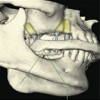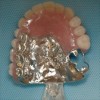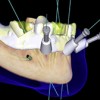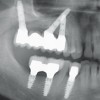A well designed removable partial denture stabilizes the remaining dentition and unites the entire arch. The cast is surveyed in order to identify the most ideal path of insertion and treatment position. The primary objective is to orient the cast that positions the teeth and associated structures in the most advantageous position (MAP). This program illustrates the methods used to survey the study cast and describes the design and fabrication of tooth preparation guides.
Removable Partial Denturs – Designing RPD’s – Surveying & Map — Course Transcript
- 1. Designing RPD’s Surveying and MAP Ting Ling Chang DDS and John Beumer III DDS, MS Division of Advanced Prosthodontics UCLA School of DentistryThis program of instruction is protected by copyright ©. No portion ofthis program of instruction may be reproduced, recorded or transferredby any means electronic, digital, photographic, mechanical etc., or byany information storage or retrieval system, without prior permission.
- 2. Designing RPD’sv Diagnostic assessment and preliminary impressionsv Diagnostic casts mounted in centric relationv Draw the ideal RPD design (on paper)v Transfer the design to the study castsv Survey the study casts and determine the most advantageous position (MAP) of the designed RPD path of insertion and withdrawalv Revise and finalize the RPD design
- 3. Designing RPD’sv Diagnostic assessment and preliminary impressionsv Diagnostic casts mounted in centric relationv Draw the ideal RPD design (on paper)v Transfer design to the study castsv Survey the study casts and determine the most advantageous position (MAP) of the designed RPD path of insertion and withdrawalv Revise and finalize the RPD design
- 4. SurveyingDefinition:v An analysis and comparison of the prominence of intraoral contours (teeth and soft tissue) associated with the fabrication of a prosthesisPurpose:v To identify the most ideal path of insertion and treatment positionv Primary objective is to orient the cast that positions the teeth and associated structures in the most advantageous position (MAP)
- 5. Other DefinitionsHeight of contour (survey line)v A line encircling the tooth and designating it greatest circumference at a selected position as determined by a dental surveyorUndercut (tooth)v The portion of the surface of the tooth which is below the height of contour in relation to the path of insertion
- 6. RPD path of insertion and withdrawalv Initial contacts on the abutment teethv The RPD continuously follows the same path guided by the proximal plates until completely seated
- 7. SurveyingGuiding surfaces v May be on the distal or mesial surfaces of the tooth adjacent to the edentulous extension areas v Other guiding surfaces contacted by rigid portions of the prosthesis (minor connectors, lingual plates)
- 8. SurveyingRetention areas v The ideal retention area is located in the gingival one third of the tooth v An given cast may present with: v Idealretention areas v Lack of retention areas v Excessive retention areas
- 9. Surveying The most advantageous position (MAP) is determined by:Retention areas v The ideal retention area is located in the gingival one third of the tooth v An given cast may present with: v Idealretention areas v Lack of retention areas v Excessive retention areas
- 10. Surveying The most advantageous position (MAP) is determined by:Retention areas v The ideal retention area is located in the gingival one third of the tooth v An given cast may present with: v Idealretention areas v Lack of retention areas v Excessive retention areas
- 11. Surveying tablev Place cast on the surveyv Insert analyzing rod (diagnostic rod)v Adjust the survey table to idealize the guide planes and undercuts Analyzing rod
- 12. Surveying – Cast orientationWhat is a good starting position? Eyeball survey by placing the cast on the survey table and standing directly over it.
- 13. Surveying – Cast orientation:What is a good starting position? v First make guiding surfaces as parallel as possible by eye
- 14. Surveying – Cast orientationv Keep the occlusal plane as close to a horizontal position as possible.v Path of insertion should closely follow the long axis of the teeth
- 15. Surveying – Cast orientationvDo not let one malpositioned abutment tooth dictate the most advantageous position (MAP)!vWe should find the MAP using majority of normal aligned abutment teeth.
- 16. v Surveying – Cast orientation Manipulate the cast position until you identify the best combination of guide plane orientation and undercutsv The ideal path of insertion allows seating of the prosthesis minimizing spaces and voids
- 17. Analysis of Retentionv Attach the retention gauge to the surveyorv The desired amount of retention is 0.25 mmv The tip extends to the height of contourv The gingival portion extends to the .25 mm (0.010”)undercutHeight ofcontour .25 mm undercut
- 18. Analysis of Retentionv Attach the retention gauge to the surveyorv The desired amount of retention is 0.25 mm Retention gauge
- 19. Tooth preparation guidesv Place a blue pencil mark on the study cast to indicate areas where the abutment teeth need to be recontouredv In this patient an occlusal adjustment will also be necessary
- 20. Analysis of Retentionv The desired amount of retention is 0.25 mmv What do we do if reasonable contours cannot be created? v Full veneer crowns
- 21. Tooth preparation guidesv Fabricate proper guide with MAP orientation to facilitate the mouth preparation guide planesv Metal posts are mounted on a record base with pattern resin to show the orientation
- 22. Tooth preparation guidesv Insert the preparation guide intraorally.v Use parallel sided bur with stable finger rest to follow the metal post orientation (MAP) for the tooth alterationv Then the preparation for the restoration can begin
- 23. v Visit ffofr.org for hundreds of additional lectures on Complete Dentures, Implant Dentistry, Removable Partial Dentures, Esthetic Dentistry and Maxillofacial Prosthetics.v The lectures are free.v Our objective is to create the best and most comprehensive online programs of instruction in Prosthodontics


 Angled Implants
Angled Implants
 Implants and RPDs
Implants and RPDs
 Computer Guided Treatment Planning and Surgery
Computer Guided Treatment Planning and Surgery
 Restoration of Posterior Quadrants and Treatment Planning
Restoration of Posterior Quadrants and Treatment Planning
